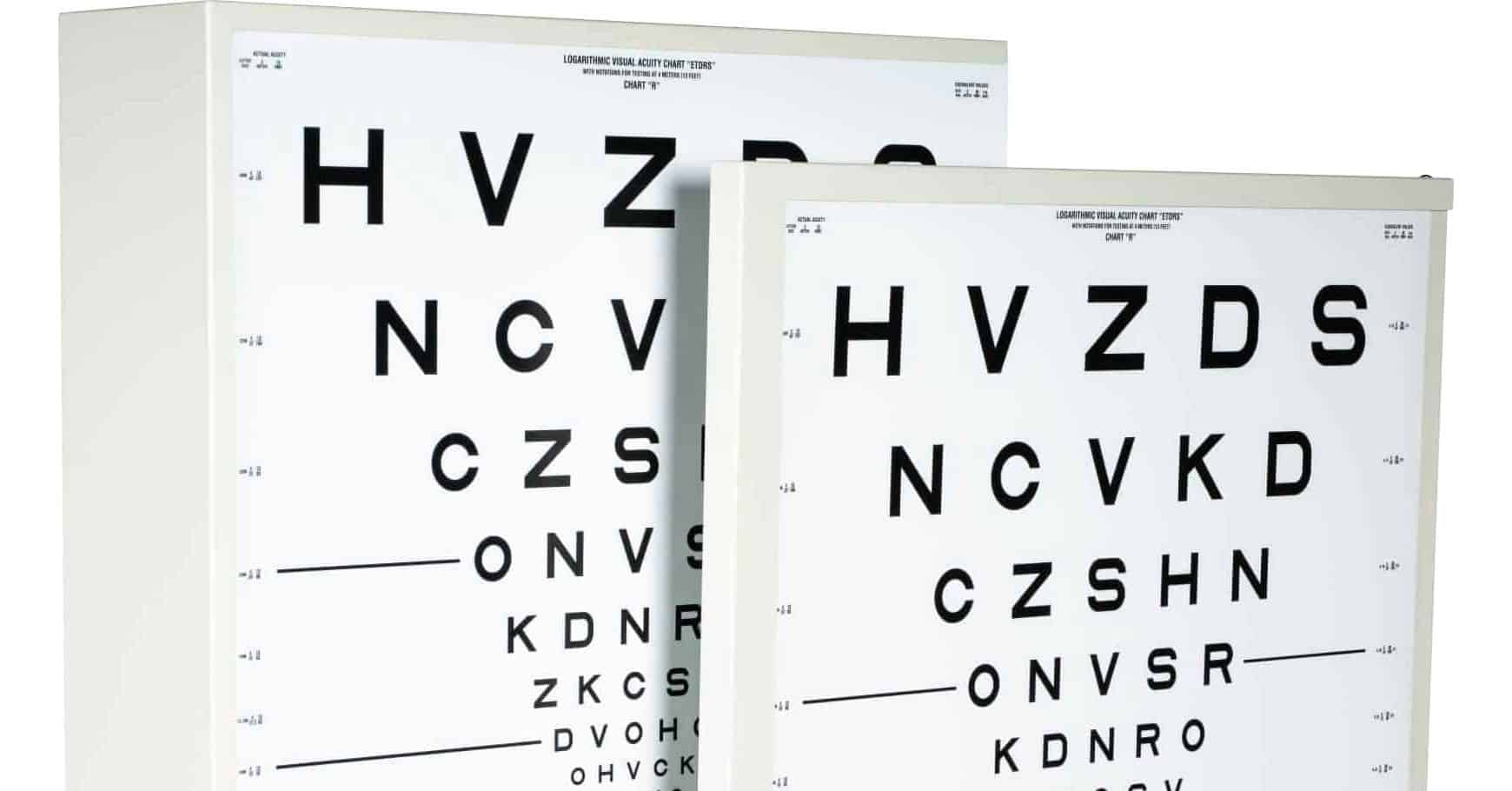
Precision Vision and ETDRS – ETDRS Charts, Illuminator cabinet – Precision Vision
IN THE NEWS
Welcome, friends. Nearly 30 years ago, a landmark study called ETDRS changed the course of vision care and treatment. ETDRS, or the Early Treatment Diabetic Retinopathy Study, was a randomized clinical trial meant to aid patients with non-proliferative or early proliferative “diabetic retinopathy”. It was historic and incredibly important to vision care and remains so today.
Did you know that Precision Vision was involved from the very beginning? Read on.
Precision Vision and ETDRS
ETDRS Background
ETDRS stands for the Early Treatment Diabetic Retinopathy Study. The randomized ETDRS clinical trial was created to evaluate the effectiveness of “argon laser photocoagulation” and “aspirin treatment” in patients with non-proliferative or early proliferative “diabetic retinopathy”. Doctors recruited 3,711 patients and followed their treatments and progress for a 4 year minimum to study treatment risks and benefits.
Before this first large multi-center study could launch, new visual acuity charts had to be established. Previous visual acuity tests, including the Snellen acuity test and Sloan acuity test, were not adequately standardized for use at many clinical centers. The development of standardized charts that later would become known as “ETDRS charts” began in 1982 by Frederick L. Ferris III, M.D., Aaron Kassoff, M.D., George H. Bresnick, M.D. and Ian Bailey, O.D., with results published in the American Journal of Ophthalmology. The work done preparing for this study helped to create important testing standardizations, including standard visual acuity eye charts and illuminator cabinets that ensure proper lighting conditions to ensure accurate and repeatable test results.
Today, ETDRS acuity testing is the recognized “Gold” standard worldwide for
visual acuity testing.
“We recently discussed the ETDRS with some of the doctors involved – August Colenbrander, M.D. and Dr. Frederick L. Ferris III, M.D. – and would like to share some of their memories with you.”
August Colenbrander, M.D. – Affiliate Senior Scientist
“I remember the first cabinet. It was a big, wooden contraption with fluorescent tubes in front of the chart. It took up a lot of space. I don’t think there was another back-lighted cabinet other than the one Ed Kopidlansky Sr. with Precision Vision made.
Ed Kopidlansky Jr. (President of Precision-Vision) said his father had experience with manufacturing many different products. Ed Sr. was the one who made the large illuminated cabinet for the first ETDRS study.”
Dr. Frederick L. Ferris III, M.D. – Director, Division of Epidemiology and Clinical Applications (DECA)
“Originally we had the charts made up in the printing shop. We had artists at NIH create the letters exactly. However, we weren’t interested in going into the visual acuity chart business. We talked to a number of people. Ed Kopidlansky Sr. was one of them. He was particularly interested in getting very involved with us and making sure the letters were exactly reprinted to the correct size, spacing, etc. We worked together on a lot of different versions of that chart (this was in the early 1980s). We found that Ed Kopidlansky Sr. reproduced them to our exacting standards.
Then we started on the lighting. We decided on a rear-illumination technique that used fluorescent light bulbs. Ed helped us develop these little baffles / screens that would go in-between the fluorescent light bulbs and the chart so that we wouldn’t have any hot spots on the eye chart, and to ensure that the illumination on the eye chart was even all across the entire chart.
When we went to this system, it was considerably easier to use and took up less space.”
Precision Vision’s Role in ETDRS
Precision Vision was called upon to develop the first commercially viable trans-illuminated charts and cabinets for ETDRS. Today, these products are still considered the world standard used in research, education and clinical settings everywhere.
Illumination standards for visual acuity testing were set by the first major ETDRS clinical trial. This retro-illuminated cabinet is still in use today and maintains a luminance level of 160-180 cd/m2. Each cabinet is set up with 2 fluorescent lamps, each lamp then incorporates a fenestrated sleeve (diffuser) to control the light level for very uniform illumination across the charts. Replacement of the lamp is simple and inexpensive. The lamps will last for years under normal conditions but they are typically replaced annually for clinical trials. The cabinet has storage in the back for quick chart access. A 5-leg caster base can be obtained for mobility or the cabinets can wall mounted.
We are deeply proud to be a part of such a landmark study, and continue to work with incredible doctors and researchers in the eye care industry.
Today, we are developing a newer version of the Original ETDRS Illuminator Cabinet™. This model will include additional features and will include a panel illuminated with LEDs. It will be a fraction of the depth of the existing cabinet which will improve its office appeal and greatly reduce shipping costs. We promise to keep you posted of our progress on this project.
PRODUCT PROFILE
ETDRS Illuminator Cabinet™ and Accessories
Gold Standard ETDRS Illuminator Cabinet™, used for more than 25 years. This cabinet has been used extensively in clinical trials and research studies worldwide since the very first ETDRS study and is a direct result of of the study itself. It fits all of our ETDRS style charts, full and low contrast. It includes a chart storage pocket in back, can be wall-mounted or used with our adjustable caster base.
National Eye Institute and FDA approved and recommended. Standardized uniform retro illumination for all 62 x 65cm (24.5 x 25.5 in.) ETDRS style charts.
Original Series ETDRS Charts
In addition to the ETDRS Illuminator Cabinet™ above, our Original Series ETDRS Charts are also a direct result of the ETDRS research and represent the Gold Standard in vision care. Originally developed by Precision Vision, they are still used extensively in research, testing and treatment.
The only standardized format accepted in studies sponsored by the National Eye Institute. Designed for use in clinical studies and low vision evaluations where accurate and repeatable visual acuity measurements are required. Geometric progression in letter size from line to line, each line is of equal difficulty.
SEE PV
Upcoming Meetings
Visit Precision Vision will be at the following meetings.

Share Your Stories With Us!
Precision Vision® wants to hear your stories. Tell us how you are impacting the industry. Do you have an interesting story to share about a Precision Vision® product? Contact us and we may use it in a future newsletter.





